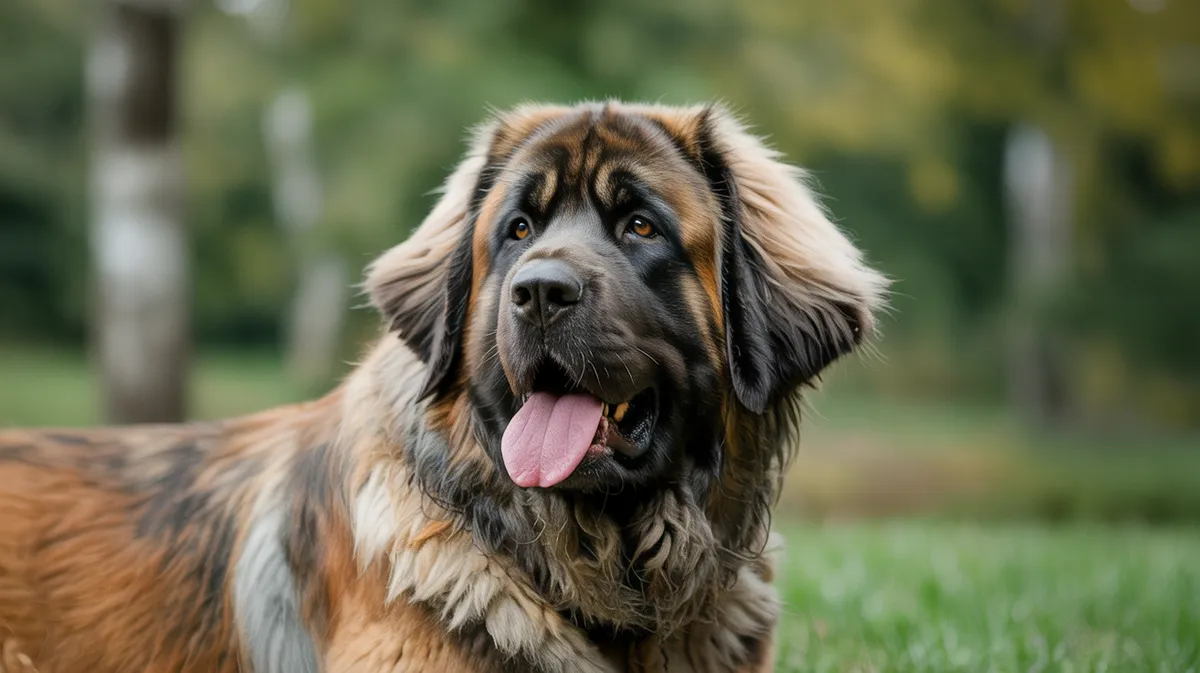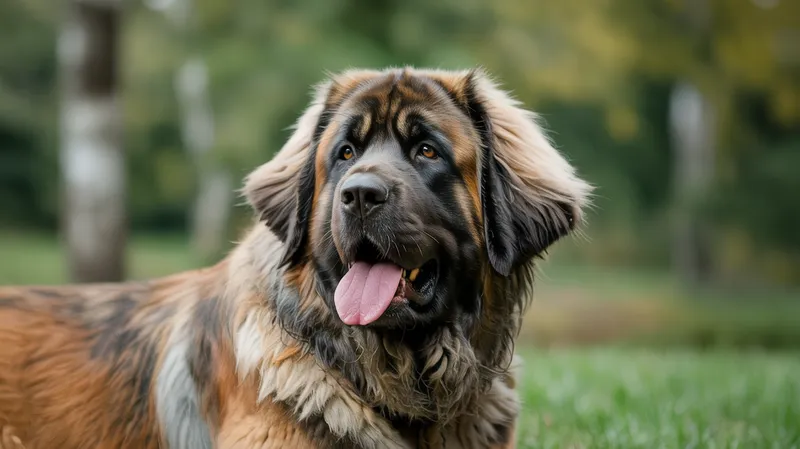
Leonberger
Canis lupus familiaris

Meet the Leonberger
The Leonberger is a giant dog breed originating from Germany, renowned for its lion-like appearance and calm temperament. These dogs were bred as working dogs and companions, often serving as watchdogs, draft animals, and family pets. Leonbergers are distinguished by their large, muscular build, thick double coat, and striking black facial mask. They are known for being gentle, intelligent, and highly loyal, making them excellent therapy and rescue dogs as well. Their friendly and social nature means they thrive in active households where they can participate in family life.
Classification
Mammal
Habitat
Domestic, often suburban or rural environments
Diet
Omnivore
Lifespan
8-9 years
Conservation
Least Concern
Weight
55–77 kg (120–170 lbs)
📖Fascinating Facts
Lion-Like Looks
The Leonberger was selectively bred to mimic the appearance of a lion, which is reflected in their impressive mane and regal stature.
Water Rescue Skills
Leonbergers have webbed feet and a powerful swimming ability, making them exceptional water rescue dogs often used in lifesaving missions.
Gentle Family Companions
Despite their imposing size, Leonbergers are remarkably gentle, patient, and affectionate, especially with children and other pets.
📋Detailed Description
The Leonberger is a giant, powerfully built dog breed, with adult males typically weighing between 48–75 kg (106–165 lbs) and females 41–59 kg (90–130 lbs). Males stand 72–80 cm (28–31.5 in) at the shoulder, while females are 65–75 cm (25.5–29.5 in) tall. The breed is characterized by a long, water-resistant double coat that forms a distinct mane around the neck and chest, reminiscent of a lion, and features feathering on the legs and tail. The coat color ranges from yellow, red, reddish-brown, to sandy, always with a prominent black facial mask. Leonbergers possess a broad, expressive head, dark almond-shaped eyes, and medium-sized, pendant ears. Their robust anatomy is complemented by a deep chest and strong, muscular limbs, adaptations that historically enabled them to work as draft and water rescue dogs. Despite their imposing size, Leonbergers are renowned for their gentle, stable temperament and high intelligence. They are highly social, forming strong bonds with family members and displaying patience and tolerance, especially with children. The breed is known for its versatility, excelling in activities such as cart pulling, water rescue, and therapy work. Their lifespan averages 8–9 years, with some individuals reaching 10 years or more with proper care.
💡 Did you know?
Despite their massive size, Leonbergers are known to be excellent swimmers and have webbed feet to aid in aquatic rescue work.
🔬Research & Sources
Wikipedia Summary
The Leonberger is a giant dog breed, whose name derives from the city of Leonberg in Baden-Württemberg, Germany.
Last Modified: 5/25/2025
🎭Behavior & Social Structure
Leonbergers are calm, confident, and even-tempered, exhibiting a strong desire for companionship and inclusion in family activities. They are not aggressive by nature but are protective and will alert their owners to unusual occurrences, making them effective watchdogs. The breed is highly trainable, responding well to positive reinforcement and consistent guidance. Leonbergers require regular mental and physical stimulation; they enjoy long walks, swimming, and structured play. Their historical use as working and rescue dogs has fostered a cooperative, people-oriented disposition. They are generally tolerant of other pets and children, displaying patience and restraint. Leonbergers are known for their 'leaning' behavior, often pressing against their owners for physical contact. Feeding behavior is typical of large breeds: they require a balanced, nutrient-rich diet to support their size and activity level, and are prone to overeating if not monitored. Daily routines should include exercise, grooming, and social interaction to prevent boredom and anxiety.
👶Reproduction & Life Cycle
Leonbergers are sexually mature by 18–24 months, though breeding is recommended after two years of age to ensure full physical development. The breed is monoestrous, with females coming into heat typically twice per year. Mating is usually managed by experienced breeders to ensure genetic diversity and health. The gestation period averages 63 days. Litter sizes range from 6 to 8 puppies, though larger litters (up to 12) are not uncommon. Neonatal care is intensive due to the puppies' size and rapid growth; breeders monitor for developmental issues such as hip dysplasia. Both parents may display nurturing behaviors, but maternal care is primary, with the dam providing warmth, grooming, and nursing for the first 3–4 weeks. Puppies are weaned by 6–7 weeks and begin socialization and basic training shortly thereafter. Responsible breeding programs emphasize health screening for hereditary conditions, particularly orthopedic and cardiac issues.
🛡️Adaptations & Survival
Leonbergers possess several adaptations suited to their historical roles as working and rescue dogs. Their dense, water-resistant double coat provides insulation against cold and wet conditions, essential for water rescue and draft work in harsh climates. The breed's large, webbed feet facilitate efficient swimming and stability on varied terrain. Their muscular build and strong neck enable them to pull carts or assist in water rescues. Behaviorally, Leonbergers are highly trainable, with a strong desire to please and an innate calmness that makes them reliable in stressful situations. Their social intelligence allows them to interpret human cues and work cooperatively in teams. The black facial mask may serve as a visual signal, enhancing facial expressiveness and communication.
📚Research Sources
🎨Cultural Significance
The Leonberger holds a unique place in European canine history. Developed in the mid-19th century by Heinrich Essig in Leonberg, Germany, the breed was intended to resemble the lion on the city's crest. Leonbergers were favored by European royalty, including Empress Elisabeth of Austria and the Prince of Wales (later Edward VII). They served as working dogs on farms, in water rescue, and as companions to nobility. Today, Leonbergers are celebrated for their service in search and rescue, therapy, and as family companions. Their lion-like appearance has made them a symbol of strength and nobility in German culture. The breed is also featured in art and literature, often representing loyalty, courage, and gentleness.
🔬Recent Research & Discoveries
Recent scientific studies have focused on the genetic diversity and health of the Leonberger breed. Genome-wide association studies have identified specific genetic markers linked to inherited diseases such as polyneuropathy and osteosarcoma. Ongoing research aims to improve early detection and management of these conditions. The breed has also been included in studies on canine cognition and social behavior, highlighting their advanced problem-solving abilities and strong attachment to humans. Veterinary research continues to refine best practices for nutrition, orthopedic health, and cardiac screening in giant breeds. International breed clubs collaborate on health registries and data sharing to track population trends and disease prevalence.
🎥Wildlife Videos

The Incredible Wildlife Living At Our Equator | Equator Specials
The sun shines most powerfully at the Equator, here it is able to power extraordinary life. From the large trees covering the ...
All Out Wildlife

Wildlife - The Fascinating World of Wild Animals | Full Series | Free Documentary Nature
Wildlife - The Fascinating World of Wild Animals | Wildlife Documentary Watch 'Ocean Stories - Full Series' here: ...
Free Documentary - Nature

Wild Canada - Nature's Untamed Beauty | Full Series | Free Documentary Nature
Wild Canada - Nature's Untamed Beauty | Wildlife Documentary Watch 'Darkwoods - Canada's Hidden Nature Reserve' here: ...
Free Documentary - Nature

Awe-Inspiring Nature Scenes in 4K UHD | BBC Earth
Enjoy the best 4K wildlife footage that BBC Earth has to offer, narrated by Sir David Attenborough, David Tennant and more!
BBC Earth

HD Animal Documentary 2021 no ads
lion fight #animals #wildlife #nature.
animal savana

The Wonder of America's National Parks | MEGA EPISODE Season 1 Full Episode
America's National Parks depicts the adventure, beauty and wonder of natural spaces. Each park is a valuable and important ...
National Geographic
🌍Habitat Information
The Leonberger typically inhabits Domestic, often suburban or rural environments environments. Leonbergers have adapted to their environments with specialized features and behaviors.
Primary Habitat:
Domestic, often suburban or rural environments
More detailed habitat information will be available soon.
🛡️Conservation Status
The Leonberger is currently classified as Least Concern. Conservation efforts are crucial for preserving this species for future generations.
Common Threats:
- 🏠Habitat loss and fragmentation
- 🌡️Climate change impacts
- 🎯Hunting and poaching
- 🏭Human-wildlife conflict
⚠️Threats & Conservation Challenges
The primary threats to the Leonberger breed are genetic health issues, including hip and elbow dysplasia, osteosarcoma (bone cancer), and inherited cardiac conditions such as dilated cardiomyopathy. The breed is also susceptible to bloat (gastric torsion), a life-threatening emergency common in deep-chested dogs. Population bottlenecks, particularly following World Wars I and II, have led to a reduced genetic pool, increasing the risk of inherited diseases. Responsible breeding practices, including health screening and outcrossing, are essential to maintain genetic diversity. Leonbergers are not considered at risk in terms of overall population, but maintaining breed health is a significant challenge. Urbanization and changes in lifestyle have reduced the demand for large working dogs, potentially impacting the breed's long-term viability. Education on appropriate care, exercise, and health monitoring is crucial for owners.
🔬Scientific Classification
Scientific Name
Canis lupus familiaris
Classification Hierarchy
🔍 About Taxonomic Classification
Taxonomic classification is a hierarchical system used by scientists to classify and organize living organisms based on shared characteristics and evolutionary relationships.
The system moves from broad categories (Kingdom) to increasingly specific ones, with each animal's scientific name typically consisting of its Genus and species.
📝Community Notes
Share your observations and insights about the Leonberger with our community of wildlife enthusiasts.
Join Our Community
Sign in to share your observations and connect with fellow wildlife enthusiasts.
Sign In to ContributeNo community notes yet
Be the first to share your observations about the Leonberger!
Explore Leonberger
Select a tab above to learn more about this amazing animal.
📸Photo Gallery
No photos available for this animal yet.
🌟Discover More Wildlife
Continue your journey of discovery with more fascinating animals from our database
